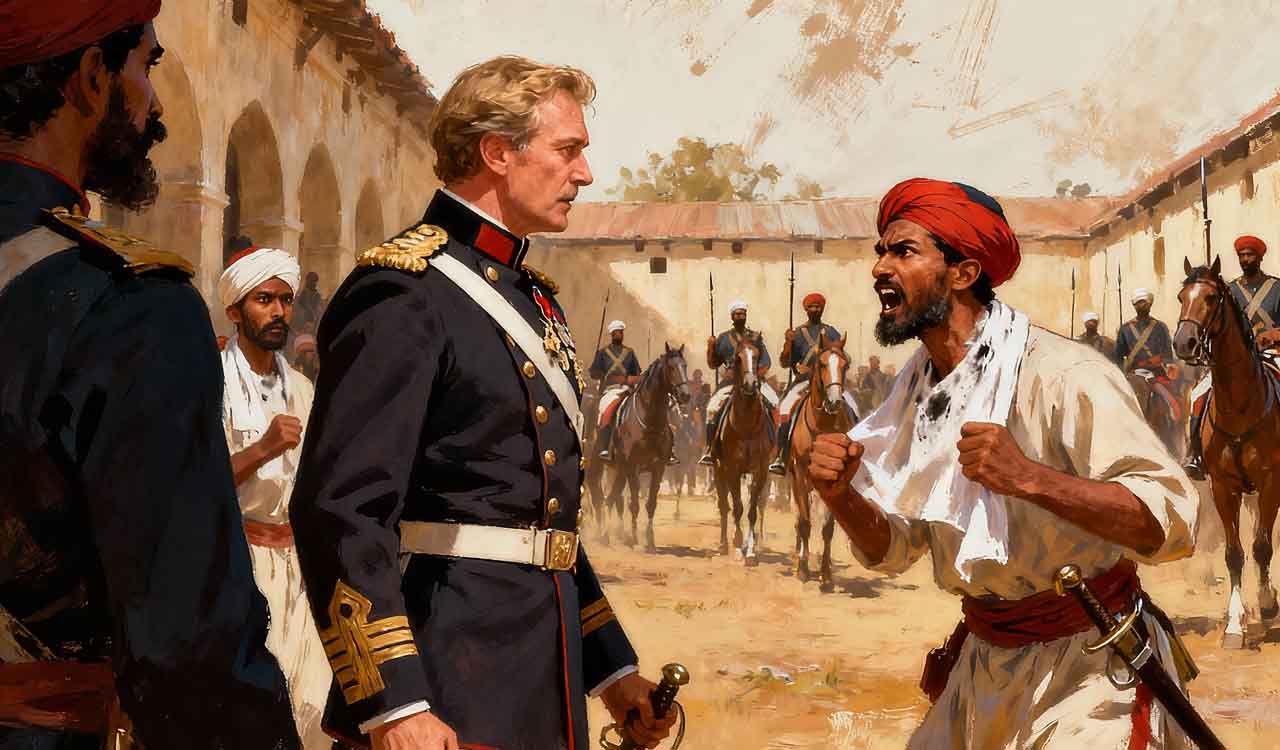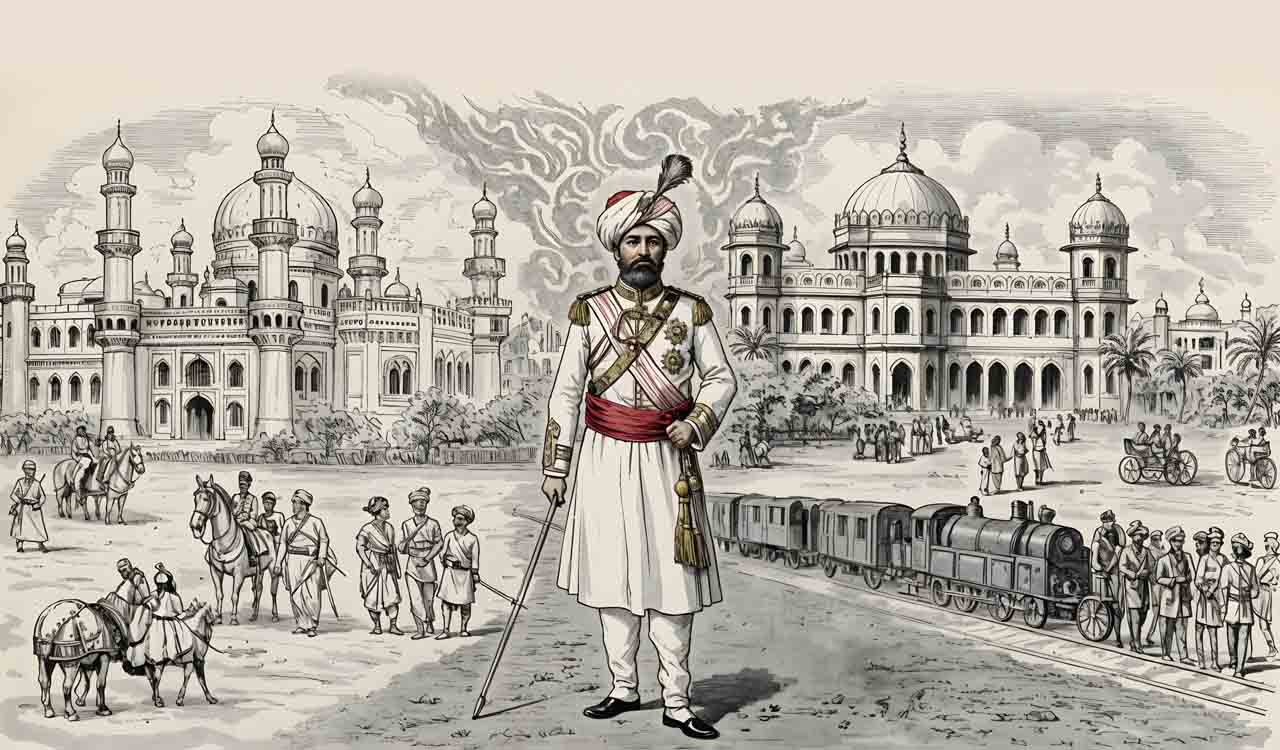Rewind: Hyderabad’s first revolt
Mominabad Mutiny of 1827 became a significant precursor to later uprisings, shaping early anti-colonial sentiment within the Nizam’s dominions

By KSS Seshan
The Azadika Amrit Mahotsav, marking 75 years of Indian independence celebrations, understandably evoked unprecedented enthusiasm among the public about how the national movement unfolded against the British in India. In the process, there has also been renewed interest in the early anti-British revolts that occurred even before the outbreak of the 1857 Revolt, generally regarded as the “First war of Independence”.
Although the pre-1857 revolts were highly localised, limited, and sporadic, they were nevertheless intense and driven by strong anti-British sentiments. They served as trendsetters for the later pan-Indian Great Revolt of 1857. In many ways, these uprisings served as catalysts, laying the much-needed ideological foundations for the more widespread movements that followed throughout the country.
Anti-British Sentiments
Anti-British revolts in Hyderabad and Andhra regions were as old as the establishment of British rule itself. In Seemandhra (Rayalaseema and Andhra), the early uprisings were mostly spearheaded by local potentates and big landlords. The Zamindars in the Circars (district) and Palegars (regional leaders) in the Ceded Districts (Rayalaseema) led such early revolts. The uprisings of the Rajas of Vizianagaram and Ganjam, as well as those led by Uyyalawada Narasimha Reddy (1846), are well known. There were also lesser-known rebellions such as the Trrnekal revolt (1801), the Chittoor Palegars’ revolt (1804) and the heroic resistance led by Rasool Khan, the Nawab of Kurnool (1839).
While several early anti-British uprisings occurred in Seemandhra, there is a misconception that such revolts were absent in Hyderabad State, ruled by the Nizam — considered a close ally of the British. Although the Nizam was hailed as a ‘Faithful Ally’ of the British after signing several alliances with the British starting from 1766, and was conferred titles like ‘His Exalted Highness’, there were occasions when serious anti-British struggles arose within his dominions. However, unlike Rayalaseema and Andhra, the revolts in Hyderabad were mostly confined to the army and were, therefore, mutinous in nature.
• The Mominabad Mutiny erupted in present-day Marathwada when British officers ordered Muslim sepoys to shave their beards, sparking an armed rebellion within the Nizam’s elite cavalry and revealing deep cultural resistance to colonial military interference
These mutinies largely stemmed from the actions of ruthless high-ranking British army officers who imposed rules that came into conflict with the religious beliefs, sentiments and practices of the local Muslim Sepoys.
The Early Uprisings
The first major revolt in Hyderabad State occurred in 1808 when Raja Mahipat Ram, a close associate of Sikandar Jah, the third Nizam (1803-1829), rose against the British. He demanded the annulment of earlier treaties signed with the British, including the one in 1766 and the Subsidiary Treaty of 1800. Mahipat Ram openly encouraged the Nizam to free himself from the British political domination. As a result, he was removed from the Governorship of Berar (in Maharashtra) and faced an armed attack by the British. Though Mahipat Ram heroically fought and even killed British Commander Major Gordon in a pitched battle at Shorapur in Hyderabad territory on 10 February 1808, he was ultimately overpowered by fresh British troops. The Nizam remained a mute spectator during his suppression.
The next significant anti-British revolt in Hyderabad was the Mutiny in Mominabad, a significant rebellion against the British in 1827. This occurred 30 years before Turrebaz Khan’s daring attack on the Residency in Hyderabad during the Great Revolt of 1857. It resulted from the anti-British sentiment among sepoys of the Nizam’s army against certain regressive policies of the British.
• Hyderabad’s early revolts—from Mahipat Ram’s 1808 defiance to the Mominabad Mutiny—underscore how princely-state armies quietly challenged British authority decades before the Great Revolt of 1857
Among all the components of the Nizam’s army, the Cavalry was considered to be the finest. It consisted of nearly 10,000 native sepoys, commanded by a few British officers. Cantonments were spread across places such as Lingsagar, Hindoli, Ellichpur, Aurangabad, Bolaram and Mominabad. The mutiny erupted in the Mominabad contingent near Jalna in the Marathwada region of the present-day Maharashtra.
Sepoys Humiliated
The Nizam’s forces were reorganised as part of British efforts to westernise the army. These reforms frequently interfered with the religious practices of Muslim sepoys, triggering resentment. Such disregard had earlier sparked the Vellore Mutiny of 1806, commonly known as the White Mutiny.
The Company administration at Madras prohibited native sepoys from wearing sacred ash or other caste marks on their forehead. Growing beards was forbidden in the name of uniformity and discipline. Long hair tied into a bun was also prohibited. Adding to it, a new uniform was introduced that included a turban with a leather cockade that resembled a Cross made of animal hide. Such acts offended both Hindu and Muslim sepoys. As a result, in July 1806, the sepoys at Vellore, about 80 km west of Madras, rose in revolt, killing nearly 120 British forces that included 15 high-ranking officers. Although it was suppressed by Col Gillespie, the Vellore Mutiny was a landmark event.
Unfortunately, similar lessons were ignored in Hyderabad, setting the stage for the Mominabad Mutiny. Even earlier, the first known military mutiny — a naval mutiny —occurred in Visakhapatnam in 1780, when sepoys resisted forced deployment to fight Hyder Ali of Mysore. The mutineers, led by Sheikh Mohammad, shot several Company officers. Lt Crips, and Cadets Kingsford Venner and Robert Rutherford were killed and many others were injured.
The Daring Attack
Since the Nizam’s troops were trained, armed and dressed along British lines, harsh disciplinary measures often created resentment among the native soldiers. An open defiance broke out in 1827 following an indiscreet order of the British Commandant at Mominabad, who, in the name of uniformity, directed Muslim sepoys to shave their beards. On 5 May, Colonel Evan Davies tried to enforce the order by having two soldiers of the Nizam’s 3rd Cavalry forcibly shaved. He declared that all others refusing to comply with the order would face similar treatment. The sepoys felt humiliated, as keeping a beard was part of their religious practice, and the order was viewed as an insult to their religious freedom.
• Despite being labelled a “Faithful Ally,” Hyderabad, under the Nizam, witnessed recurring anti-British uprisings as reforms, cantonment pressures and cultural impositions created fault lines, culminating in mutinies that shaped the region’s early anti-colonial sentiment
The next day, the sepoys assembled on the parade grounds with loaded weapons and decided to defy the order. When Col Davies approached them, the infuriated soldiers shot him at close range. The rebels were quickly overpowered by loyal soldiers and European officers. A court-martial was convened, and all participants in the mutiny were severely punished.
The Mominabad Mutiny of 1827 became a precursor to a series of revolts in the Nizam’s army. The Wahabi conspiracy of Mubarez-ud-Daulah in 1839 — the younger brother of Nizam Nasir-ud-Daulah — sought to incite an uprising against the British. This was followed by the Bolarum Mutiny in 1855 when Nizam’s Cavalry revolted after Commandant Colin Mackenzie prohibited their Muharram procession. Two years later, in 1857, the British Residency in Hyderabad was attacked, but the uprising was crushed by the Diwan, Sir Salar Jung I, for which he was rewarded by the British with the title ‘Grand Commander of the Star of India’ (G.C.S.I).
British Ascendency In Hyderabad
Hyderabad’s tryst with the British began quite early. Under the Treaty of 1766, when the Northern Circars were ceded by the Nizam, British influence began to be felt. It steadily increased after the arrival of Holland in 1778 as the envoy of the East India Company to the Nizam’s court. The system of appointing successive British Residents under the Subsidiary system took firm shape after 1800. Initially, the Residents occupied the garden house of Mir Alam, the Prime Minister, before the magnificent Residency was built by James Achilles Kirkpatrick in 1806.
A small British colony known as the Residency Bazaar developed around the Residency in the Koti area. A similar colony came up in Secunderabad after the British Cantonment. English influences in Hyderabad thus grew steadily.
A few Hyderabadi nobles also came under the influence of the English language and British social life. Shams-ul-Umra, a prominent Paigah nobleman, not only embraced Western education and values but also took a keen interest in Western thought and literature. The large contingents of British troops and British officers in Nizam’s army further facilitated close interactions between the British and the natives of Hyderabad.
There was a steady influx of Sikhs from Punjab, and leading families from the United Provinces and Delhi. Maratha political life also dominated. The people of Hyderabad now closely followed developments across India. Raja Chandulal, the Prime Minister (1808-1843), himself a Punjabi, attracted many Sikhs to Hyderabad State. Maharaja Ranjit Singh, the ruler of Punjab, is even believed to have written to Hyderabad’s minister about relations with the British. British policies in India, their Afghan engagements, and campaigns in Burma were followed keenly in Hyderabad.
However, as the British expanded, anti-British sentiments also grew steadily. By the first half of the 19th century, Hyderabad was absorbing Western knowledge while simultaneously keeping alive the spirit of resistance.
After the Subsidiary Alliance Treaty, several reforms were initiated in the Nizam’s forces. Henry Russell, Resident from 1811, reorganised the army and formed the Russell Brigade in 1813, considered one of the most disciplined and highly competent battalions in India. Sir Charles Metcalfe, who succeeded Russell in 1820, made further improvements.

(The writer is retired Professor of History, University of Hyderabad)
Related News
-
Three Americans killed; U.S. vows response to ISIS attack in Syria
4 hours ago -
Women’s rescue team shines as Singareni wins big at All India Mines Rescue Competition
4 hours ago -
Komuravelly Kalyana Mahotsavam to mark start of annual jathara
5 hours ago -
Over 8 lakh voters to cast ballots in Arunachal polls on Dec 15
5 hours ago -
AIIMS-led trial proves Supernova Stent safe and effective for stroke patients
5 hours ago -
Man killed, wife injured in Sangareddy road accident ahead of panchayat polls
5 hours ago -
Nitish Kumar Reddy claims hat-trick for Andhra in Syed Mushtaq Ali Trophy
5 hours ago -
Triveni Continental Kings eye hat-trick in Global Chess League
6 hours ago




